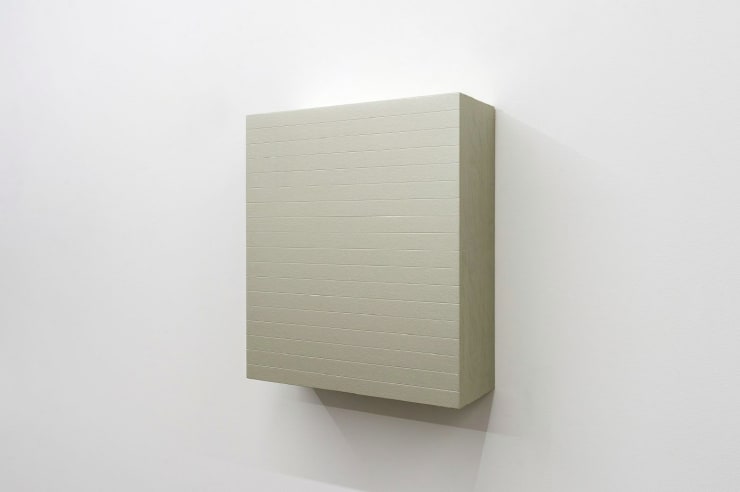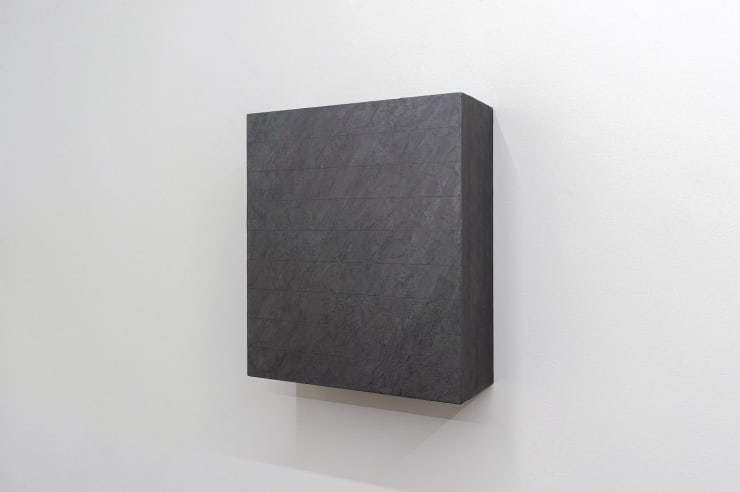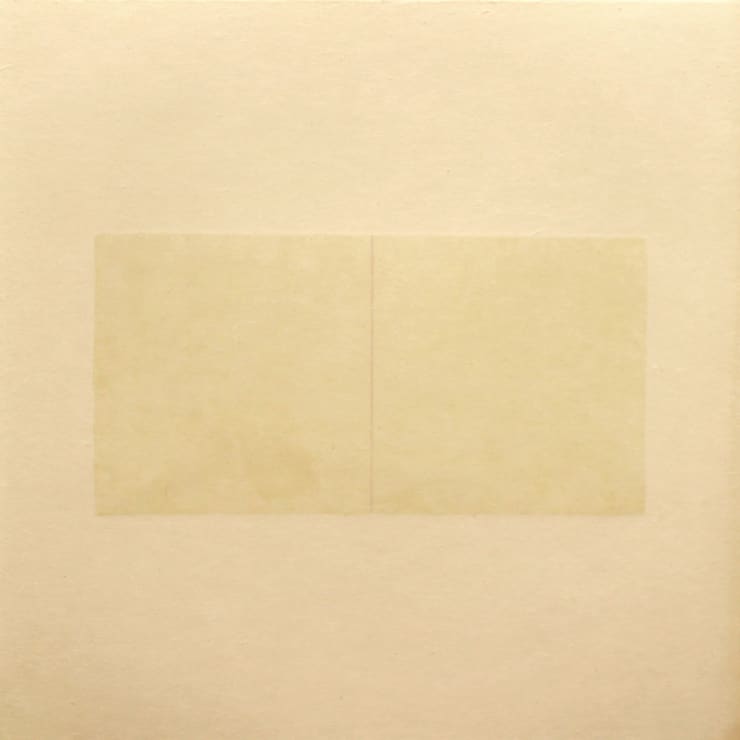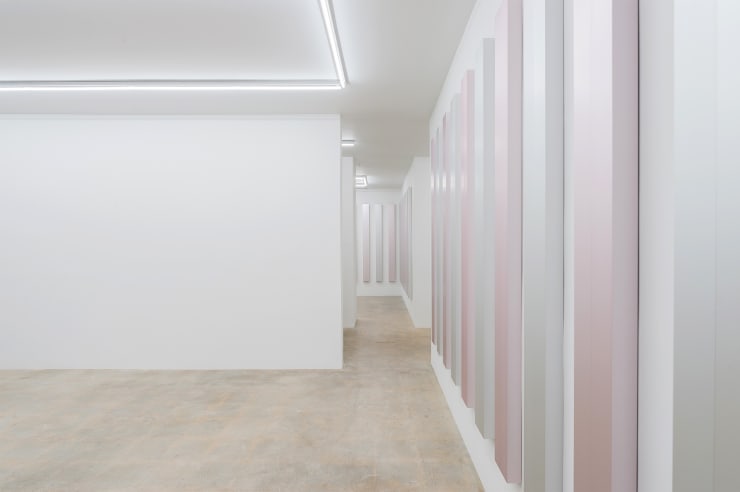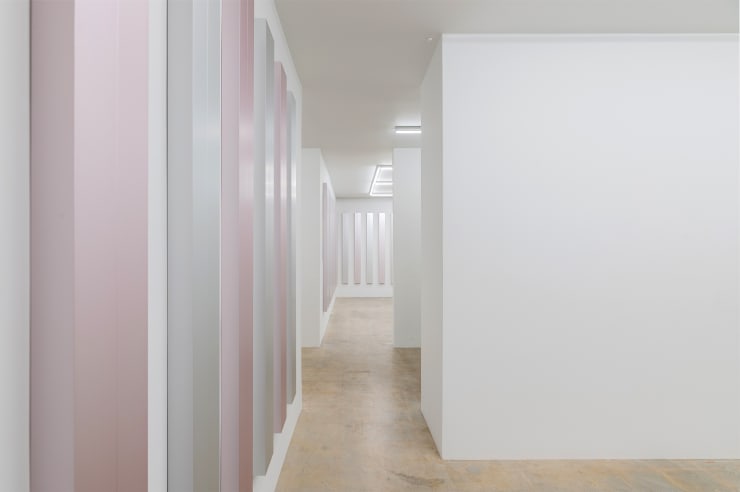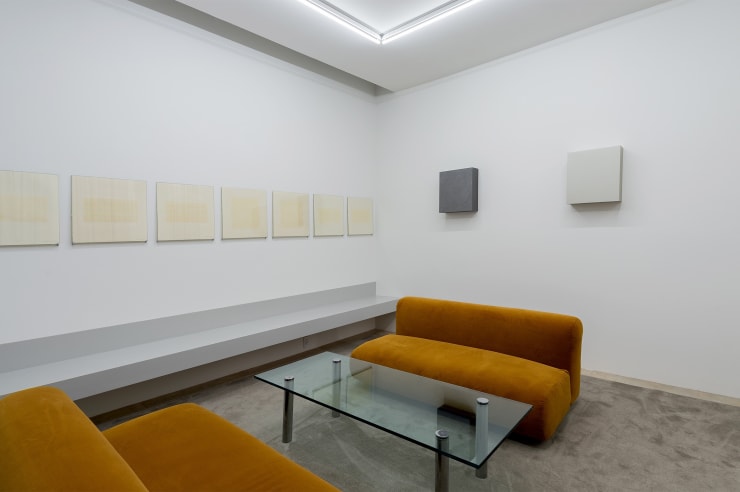Tadaaki Kuwayama
Press:
artnet news, February 12, 2019
Art Viewer, February 14, 2019
Contemporary Art Review Los Angeles (Carla), February 6, 2019
Nonaka-Hill is pleased to announce a solo exhibition by New York based artist, Tadaaki Kuwayama. The exhibition will be his first on the West Coast.
Ideas, thoughts, philosophy, reasons, meanings, even the humanity of the artist, do not enter into my work at all. There is only the art itself. That is all.
Tadaaki Kuwayama, Art in America, August issue, 1964(vol. 52, no.4)p. 100
Kuwayama has consistently produced reductivist artworks since moving to New York in 1958. Widely recognized as one of the pioneers of American Minimalism of the 1960s, he had solo exhibitions at the Green Gallery in 1961 and 1962. His status as a globally acclaimed Minimalist, however, is premised on the categorization of his art into styles such as “color field painting” and “monochrome painting” in relation to preexisting evaluation criteria. By exploring the material of his works with a spirit of experimentation, Kuwayama has, in fact, pursued unprecedented beauty.
What an artist often gives as a ‘statement’ is no more than the description of the process of how his work is made and an explanation of the materials used. Words about the work become unnecessary. Looking at the work gives a clearer explanation than words.
Tadaaki Kuwayama, “On my work”, Art Now, vol. 2, page unknown. Republished in Flash Art, June issue, 1963, P.16
Kuwayama’s oeuvre can be understood as spanning several periods during which he used different materials. Until 1962, when he had his second solo exhibition in the U.S., he produced paintings using Japanese mineral pigments and acrylic solvent on boards wrapped in Japanese paper. After that and until about 1969, he used acrylic paint; in the 1970s, he used metallic paints; and in the 1980s, he painted in oil. Since the 1990s, he has made space itself his work.
The exhibition will feature a 1999 installation comprising multiple anodized aluminum panels, alternating natural aluminum color with pink. The gallery will be transformed into an unfamiliar space, which will in turn be reduced to a work, and provide viewers with a new sensory experience.
Tadaaki Kuwayama was born 1932 in Nagoya. After graduating from the Japanese Painting course at the Tokyo University of the Arts in 1958, he moved to the United States, and has been based in New York since. Early on, he produced works using Japanese mineral pigments and paper. After his solo exhibition at Green Gallery in 1961, he began making monochromatic acrylic paintings that were combined to make geometric forms and pioneered the American Minimalist movement in the 1960s and 1970s. His globally acclaimed works, which are intended to be pure art and provide pure art experiences, display no subjective expression. His solo exhibitions include The Museum of Modern Art, Hayama (2012); The National Museum of Art, Osaka (2011); the 21st Century Museum of Contemporary Art, Kanazawa (2011); the Nagoya City Art Museum (2010); the Rupertinum Museum, Salzburg (2000); the Kawamura Memorial Museum of Art, Sakura and the Chiba City Museum of Art (both 1996); the Kitakyushu Municipal Museum of Art, Fukuoka (1985). His works have also been included in numerous group exhibitions including “Surface, Support, Process: The 1960s Monochrome in the Guggenheim Collection,” the Solomon R. Guggenheim Museum, New York (2011); “The Third Mind: American Artists Contemplate Asia, 1860-1989,” the Solomon R. Guggenheim Museum, New York (2009); “Japanese Art After 1945: Scream Against the Sky,” the San Francisco Museum of Art (1995); “Vormen van de Kleur,” the Stedelijk Museum Amsterdam (1966-67). His works are also included in the collections of the Solomon R. Guggenheim Museum, New York; The Museum of Modern Art, New York; the Albright-Knox Art Gallery, Buffalo; the Nationalgalerie, Berlin; the Foundation for Constructivist, Concrete and Conceptual Art, Zurich; The National Museum of Modern Art, Tokyo; The National Museum of Art, Osaka and others
 Tadaaki KuwayamaUntitled, 1999Anodized aluminum. 90 units.86-1/2 x 7 x 2-1/2 inches, each (219.7 x 17.8 x 6.4 cm) / 108 linear feet
Tadaaki KuwayamaUntitled, 1999Anodized aluminum. 90 units.86-1/2 x 7 x 2-1/2 inches, each (219.7 x 17.8 x 6.4 cm) / 108 linear feet Tadaaki KuwayamaTK2743-1/4-75, 1975Metallic paint on canvas, aluminum. (silver)43-1/4 x 43-1/4 inches (109.9 x 109.9 cm)
Tadaaki KuwayamaTK2743-1/4-75, 1975Metallic paint on canvas, aluminum. (silver)43-1/4 x 43-1/4 inches (109.9 x 109.9 cm) Tadaaki KuwayamaTK3343-1/4-75, 1975Metallic paint on canvas, aluminum. (gold)43-1/4 x 43-1/4 inches (109.9 x 109.9 cm)
Tadaaki KuwayamaTK3343-1/4-75, 1975Metallic paint on canvas, aluminum. (gold)43-1/4 x 43-1/4 inches (109.9 x 109.9 cm) Tadaaki KuwayamaTK4718-5-3/5-92, 1992Oil on paper on board.18 x 15-3/4 x 5-3/4 inches,
Tadaaki KuwayamaTK4718-5-3/5-92, 1992Oil on paper on board.18 x 15-3/4 x 5-3/4 inches,
45.7 x 40 x 14.6 cm Tadaaki KuwayamaTK4918-5-5/8-90, 1990Black (D gray) oil on paper on board.18 x 15-3/4 x 5-3/4 inches, 45.7 x 40 x 14.6 cm
Tadaaki KuwayamaTK4918-5-5/8-90, 1990Black (D gray) oil on paper on board.18 x 15-3/4 x 5-3/4 inches, 45.7 x 40 x 14.6 cm
Tadaaki Kuwayama TK1218-96, 1996

Tadaaki Kuwayama TK1318-96, 1996

Tadaaki Kuwayama
TK1418-96, 1996
Tadaaki Kuwayama
TK1518-96, 1996
Tadaaki Kuwayama
TK1618-96 1996, 1996
Tadaaki Kuwayama
TK1718-96, 1996

Tadaaki Kuwayama
TK1818-96, 1996

Tadaaki Kuwayama
TK1918-96, 1996

Tadaaki Kuwayama
TK9459-3/4-68, 1968
Related artist
Artist Exhibited:
Ulala Imai
Kazuo Kadonaga
Kentaro Kawabata
Zenzaburo Kojima
Kisho Kurokawa
Tadaaki Kuwayama
Toshio Matsumoto
Keita Matsunaga
Yutaka Matsuzawa
Kimiyo Mishima
Kunié Sugiura
Takuro Tamayama
Tiger Tateishi
Sofu Teshigahara
Shomei Tomatsu
Wataru Tominaga
Hosai Matsubayashi XVI
Kansuke Yamamoto
Masaomi Yasunaga
Exhibitions:
-2025-
Sea of Mud, Wall of Flame: Satoru Hoshino and Masaomi Ysunaga
KEY HIRAGA: The Elegant Life of Mr. H
-2024-
KYOKO IDETSU: What can an ideology do for me?
KENTARO KAWABATA / BRUCE NAUMAN
SAORI (MADOKORO) AKUTAGAWA: CENTENARIA
Keita Matsunaga : Accumulation Flow
-2023-
NONAKA-HILL ♥ TATAMI ANTIQUES: A holiday sale of unique objects from Japan
TAKASHI HOMMA : REVOLUTION No.9 / Camera Obscura Studies
TATSUMI HIJIKATA THE LAST BUTOH: Photographs by Yasuo Kuroda
Kiyomizu Rokubey VIII: CERAMIC SIGHT
Masaomi Yasunaga: 石拾いからの発見 / discoveries from picking up stones
SHUZO AZUCHI GULLIVER ‘Synogenesis’
Koichi Enomoto: Against the day
Tatsuo Ikeda / Michael E. Smith
Hiroshi Sugito: the garden with Zenzaburo Kojima
Zenzaburo Kojima: This very green
Tomohisa Obana: To see the rainbow at night, I must make it myself
Daisuke Fukunaga: Beautiful Work
- 2021 -
Natsuyasumi: In the Beginning Was Love
Takashi Homma: mushrooms from the forest
– 2020 –
Hosai Matsubayashi XVI & Trevor Shimizu
Sterling Ruby and Masaomi Yasunaga
– 2019 –
A show about an architectural monograph
Yutaka Matsuzawa
Yutaka Matsuzawa through the lens of Mitsutoshi Hanaga
Takuro Tamayama & Tiger Tateishi
Kunié Sugiura
Masaomi Yasunaga
Miho Dohi
Wataru Tominaga
Naotaka Hiro
Parergon: Japanese Art of the 1980s and 1990s
Tadaaki Kuwayama
– 2018 –
Toshio Matsumoto
Kentaro Kawabata
Kansuke Yamamoto
Kazuo Kadonaga: Wood / Paper / Bamboo / Glass
Press:
-2025-
ARTFORUM, Sawako Goda
Artillery Magazine, Sawako Goda
-2024-
Artsy, Nonaka-Hill
Richesse, Nonaka-Hill Kyoto
Bijutsutecho, Nonaka-Hill Kyoto
The Art Newspaper, Nonaka-Hill Kyoto
Meer, Kyoko Idetsu
Bijyutsutecho, Masaomi Yasunaga
Switch, Masaomi Yasunaga
ARTnews JAPAN, Masaomi Yasunaga
Richesse, Masaomi Yasunaga
Art Basel, Daisuke Fukunaga, Imai Ulala
Art Basel, Kazuo Kadonaga, Sofu Teshigahara
-2023-
ADF webmagazine, Yasuo Kuroda, Tatsumi Hijikata
e-flux, Sanya Kantarofsky, Yasuo Kuroda
Los Angeles Times, Kenzi Shiokava
Artillery, Masaomi Yasunaga
Contemporary Art Daily Shuzo Azuchi Gulliver
- 2022 -
Contemporary Art Daily, Tomohisa Obana
ARTE FUSE, Daisuke Fukunaga
Contemporary Art Daily, Daisuke Fukunaga
Contemporary Art Review Los Angeles (Carla), Daisuke Fukunaga
What's on Los Angeles, Daisuke Fukunaga
Hyperallergic, Daisuke Fukunaga
Artillery, Kentaro Kawabata
Larchmont Buzz, entaro Kawabata
- 2021 -
Art Viewer, Natsuyasumi: In the Beginning Was Love
Hyperallergic, Natsuyasumi: In the Beginning Was Love
Art Viewer, Takashi Homma
Hyperallergic, Busy Work at Home
Art Viewer, Busy Work at Home
Hyperallergic, Ulala Imai
Contemporary Art Review Los Angeles (Carla), Ulala Imai
Contemporary Art Daily, Ulala Imai
artillery, Ulala Imai
Special Ops, Ulala Imai
Art Viewer, Ulala Imai
artillery, Matsubayashi & Trevor Shimizu
– 2020 –
Ceramic Now, Sterling Ryby and Masaomi Yasunaga
Hypebeast, Sterling Ryby and Masaomi Yasunaga
Art Viewer, Sterling Ruby and Masaomi Yasunaga
Air Mail, Sterling Ruby and Masaomi Yasunaga
Los Angeles Times, Kaz Oshiro
ArtnowLA, Kaz Oshiro
What's on Los Angeles, Kaz Oshiro
KCRW, Kaz Oshiro
Tique, Kaz Oshiro
Contemporary Art Daily, Kaz Oshiro
Art Viewer, Kaz Oshiro
Contemporary Art Daily, Sofu Teshigahara
Art Viewer, Sofu Teshigahara
KCRW, Sofu Tsshigahara
Hyperallergic, Nonaka-Hill
Los Angeles Times, Keita Matsunaga
– 2019 –
Los Angeles Times, Tatsumi Hijikata
Art Viewer, Tatsumi Hijikata, Eikoh Hosoe
Contemporary Art Review Los Angeles, Tatsumi Hijikata, Eikoh Hosoe
ArtAsiaPacific, Yutaka Matsuzawa
Los Angeles Times, Tatsumi Hijikata
AUTRE, Tatsumi Hijikata, Eikoh Hosoe
Los Angeles Times, Nonaka-Hill
ARTFORUM, Takuro Tamayama, Tiger Tateishi
Art Viewer, Takuro Tamayama, Tiger Tateishi
KCRW, Nonaka-Hill
LA WEEKLY, Nonaka-Hill
AUTRE, Takuro Tamayama, Tiger Tateishi
ArtsuZe, Takuro Tamayama, Tiger Tateishi
ARTFORUM, Review: Tadaaki Kuwayama, Rakuko Naito
Art Viewer, Masaomi Yasunaga, Kunié Sugiura
Los Angeles Times, Masaomi Yasunaga
KQED, Tadaaki Kuwayama, Rakuko Naito
Contemporary Art Daily, Naotaka Hiro, Wataru Tominaga, Miho Dohi
Los Angeles Times, Miho Dohi
Los Angeles Review of Books, Miho Dohi
Bijutsu Techo, Naotaka Hiro, Wataru Tominaga, Miho Dohi
Art Viewer, Miho Dohi
Art & Object, Parergon
COOL HUNTING, Felix Art Fair
Art Viewer, Tadaaki Kuwayama
artnet news, Nonaka-Hill
Contemporary Art Review Los Angeles (Carla), Tadaaki Kuwayama
– 2018 –
Art Viewer, Kentaro Kawabata
Contemporary Art Daily, Kazuo kadonaga
Los Angeles Times, Kazuo Kadonaga
ARTFORUM, Kazuo Kadonaga
Contemporary Art Daily, Shomei Tomatsu
KCRW, Kimiyo Mishima, Shomei Tomatsu
This website uses cookies
This site uses cookies to help make it more useful to you. Find out more about cookies.




